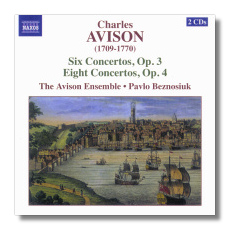
The Internet's Premier Classical Music Source
Related Links
- Latest Reviews
- More Reviews
-
By Composer
-
Collections
DVD & Blu-ray
Books
Concert Reviews
Articles/Interviews
Software
Audio
Search Amazon
Recommended Links
Site News
 CD Review
CD Review
Charles Avison

- Six Concertos, Op. 3
- Eight Concertos, Op. 4
The Avison Ensemble/Pavlo Beznosiuk
Naxos 8.557905-06 DDD 2CDs: 54:43, 76:34
Charles Avison (1709-1770) is most famous for a set of 12 Concerti Grossi he arranged from selected keyboard sonatas by Domenico Scarlatti. They have been recorded several times, on both modern and period instruments. Avison wrote more than 80 original string concertos, however. Some of these, lost for more than two centuries, recently were rediscovered, and The Avison Ensemble was formed specifically to perform and record them. The twelve concertos of Op. 6 already have been issued on CD (Naxos 8.557553-54), and now the same performers are back to tempt us with recordings of the complete Op. 3 and Op. 4 concertos.
Avison was a member of the generation after Handel, who had become an integral part of the English music scene during Avison's childhood. Contrary to the dominant tastes of the time, however, Avison preferred the instrumental music of the Italian masters… not just Scarlatti and Corelli, but also Geminiani, whom Avison actually preferred to Handel. It is not surprising, then, that Avison's music is so influenced by Italian composers of that era. At the time of his death, he was regarded by many as England's greatest composer. Today, his music seems a little old-fashioned for the era in which it was written, but it is elegant but genially uncomplicated.
Both the Op. 3 and Op. 4 concertos are written in the form of the concerto grosso, which means that a smaller group of instruments (the concertino group) is contrasted with the full string ensemble and harpsichord (the ripieno group). There are no woodwinds and no brass instruments. Between Op. 3 and Op. 4, there are no striking differences in style. The former appeared in 1751, and the latter appeared four years later. Most of the concertos are in four movements, with fast and slow movements alternating. There are interesting exceptions, however, among them Op. 4, #6, which contains six movements, including a "Fuga da capella" and a "Fuga del teatro."
The Avison Ensemble plays on period instruments, but without astringency. Unfortunately, Naxos doesn't list the individual performers, but this sounds like a medium-sized group. It is not so anemic that it denies the music its deserved weight, nor so large that it loses responsiveness and transparency of texture. Beznosiuk does not choose frantic tempos – a frequent problem with performances in an "authentic" style. Beznosiuk and The Avison Ensemble let the music unfold with unhurried serenity and grace. The recordings were made in a church in Avison's birthplace, Newcastle-on-Tyne. The church makes its own atmospheric contribution to the sound on this CD.
Copyright © 2006, Raymond Tuttle




















